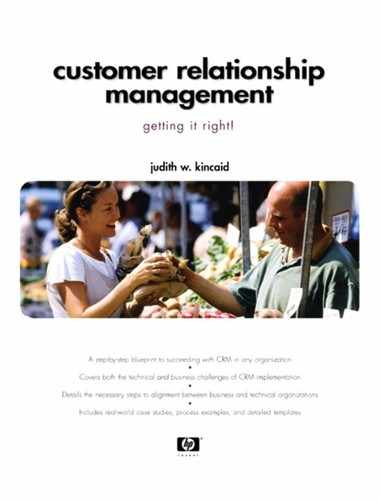12.3. Choosing Process Automation Software
After you've decided to automate a process, the question becomes “build or buy?” This question has been asked more often as more and better software solutions are available for purchase. There is no perfect CRM solution that can possibly meet every company's needs, but custom-built solutions are notoriously difficult to build and extremely expensive to maintain. Educated tradeoffs must be made. We will discuss this dilemma in Chapter 13 when we look at the technology component.
Frequently, company officials hire large consulting organizations to help them understand their processes and pick the best software solution. This can be a good way to jump-start your analysis process and make quick progress. But it's important that your business experts are closely involved in explaining and documenting the key business processes. A consultant can be a good source of recommending process improvements as long as he well understands your business.
12.3.1. Know your own processes first, and then buy a solution that fits
Whether you build or buy, you can never be successful unless you understand exactly what processes your company uses to interact with customers. In the past, companies have tried one or both of these two approaches:
Automate activities that are not tuned for a technology solution.
Force-fit a solution onto existing processes without managing the fit.
The biggest problem with the first approach is that automating poor processes doesn't improve the process, nor does it do anything for the customer experience. The problem with the second approach is that people resist change anyway, and when a new technology makes their job harder to do (or they think it will be harder), they won't adopt it, and the project will fail. We need to understand our processes to tune them for how computers work, and then find a solution that best matches what we need to get done. For now, we will just focus on what we need to know about our processes to make the best decision.
Warning: Don't be in love with your own processes. If one of the tools you evaluate supports a better process than the one you're using, be open to change.
12.3.2. Technology doesn't fix broken processes
Let me say it again: “A broken process will not be fixed by technology!” There is no magic. To the contrary, poor processes are usually made worse by automation. You simply have an opportunity to accomplish so much more of the wrong thing faster. As part of the process component of each project, you must understand the process steps in detail, identify and fix process weaknesses, and then map them to potential software solutions.
12.3.3. Managing processes across organizational boundaries
Just as we saw in Figure 12-4, it is rare indeed for processes that impact the customer experience to be completely managed within one organizational unit. For the Valencia project, we can see that both sales and marketing organizations are involved, but the end result to the customer (receiving the product that was ordered) is dependent on the back office functions of manufacturing and logistics. Although we will not cover the back office elements of the customers' experience, the methods we adopt to manage the white space in the front office can be applied to back office white space, too. The most important outcome of the process-engineering step is to understand the following:
-
The work goal
-
The steps that need to get done (workflow) to reach the goal
-
Who is responsible for which steps
-
What needs to happen in the handoff (the white space)
-
How you measure that you've reached your goal
After we've identified these items, we are ready to start thinking about what the technology component needs to look like.
